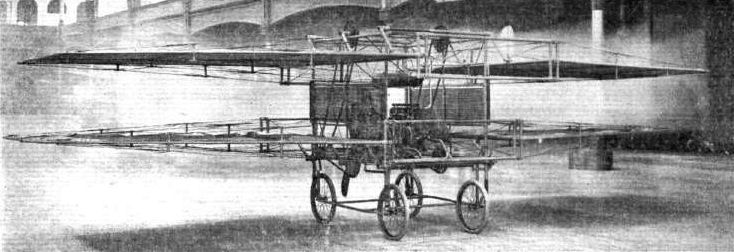P.Lewis British Aircraft 1809-1914 (Putnam)
Bartelt Ornithopter
The Bartelt Ornithopter was designed by F. T. Bartelt, J.P., of Corston Lodge, Brislington, Bristol, who was the chairman of the Polysulphin Co. Ltd. The machine was shown at the 1911 Olympia Aero Show, and was powered by a 40 h.p. engine mounted between the lower pair of wings. Chain-drive imparted 50-60 revolutions per minute to the two pairs of movable wings which were superimposed upon each other, acting alternately with a rotary action horizontally. On the upward movement, the wings deflated; when flapping downward, they inflated. The Ornithopter was expected to be able to move backwards or forwards by means of a reversing gear. Each pair of half-wings was 13 ft. in span, with the chord tapering from 12 ft. at the roots to 7 ft. at the tips. Radiators were mounted horizontally on the frames beside the twin seats, behind which was a pusher propeller.
Показать полностью
M.Goodall, A.Tagg British Aircraft before the Great War (Schiffer)
Deleted by request of (c)Schiffer Publishing
BARTELT ornithopter (F.T. Bartelt J.P., Corston Lodge, Brislington, Bristol)
This biplane-like machine with beating wings was designed by the chairman of the Polysuphin Co. Ltd. of Bristol and was exhibited at the Olympia Aero Show in March 1911.
The rectangular center structure was made of steel tubing and mounted the engine, radiators and chain and crank drive mechanism, which actuated the top and bottom wings alternatively to provide a beating motion in both forward and reverse directions.
The wings, which were tapered, were also made of steel tubing and braced by wires. The fabric covering was loosely applied with the object of this billowing out on the down-stroke to hold the maximum of air.
No further reports of progress appeared and it is certain that this machine was not successful.
Power: 40hp Star four-cylinder inline water-cooled (113 m/m bore 126 m/m stroke)
Data
Span 30ft 6in
Taper 12ft at root to 7ft at tip
Length 12ft.
Показать полностью
Журнал Flight
Flight, March 25, 1911
AEROPLANES.
F. T. Bartelt. - An entirely original type of machine invented by Mr. F. T. Bartelt, Chairman of the Polysulphin Co., Ltd., of Bristol. At first glance this new invention reminds one in outline of an ordinary biplane, but, scrutinized in detail, it is at once found to be very different. It is true that there is a wooden propeller, and bicycle wheels are provided for the runs along the ground when starting or alighting, but the surfaces, which for the moment one may mistake for planes, are, as a matter of fact, movable wings, and in these lies the essence of the invention. There are four wings, two - one above the other - on each side. The engine - a 40-h.p. aviation engine with four fixed cylinders - works the wings by means of a chain-drive, which actuates a series of cranks. The result is that the wings beat with great force; when the upper wings have made their stroke, the stroke of the lower wings immediately follows, thus ensuring a smooth continuity in the propulsion. The wings consist of aerocloth laced to frames made of steel tubing. Each frame is 13 ft. long, 12 ft. broad at the base, and 7 ft. at the end, giving the wing a graceful taper. Instead of the aerocloth being strained over the frames as in aeroplanes, a considerable amount of slack is allowed, with the result that at each flap the wing gives the fabric well swell out into a kind of pocket. It's expected that this will give enormous lifting power, and, of course, the sustaining surface will be much bigger than if the wings were flat, or only slightly curved
Flight, April 1, 1911.
Third International Aero Exgibition at Olympia - 1911.
THE EXHIBITS ANALYSED.
<...>
The Bartelt machine is something apart from all accepted types. It consists of a steel structure of biplane appearance with loose saggy wing surfaces. The wings are mounted at their shoulders on cranks, whereby they rise and fall, while always remaining parallel to the ground. The motion of the cranks being circular, the wings, simultaneously with their rise and fall, move forwards and backwards - in other words, they perform a modified form of paddle action, the object being to derive support by beating the air. The wing motion is obtained from chain transmission, and in addition to the supporting reaction, there is said to be a propelling force sufficient to keep the machine going without the small propeller that is such a comparatively insignificant constructional feature of the machine as a whole. We are informed that the small scale prototype of the machine exhibited actually flew with a pilot weighing 8 stone 4 lbs.
<...>
Показать полностью



